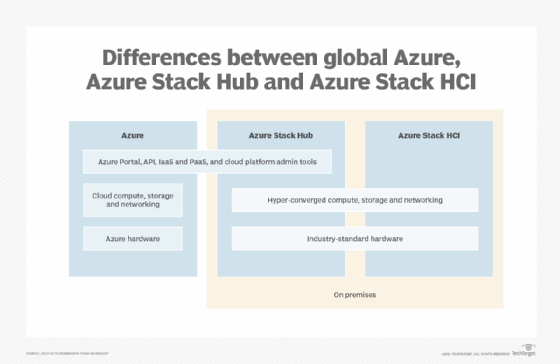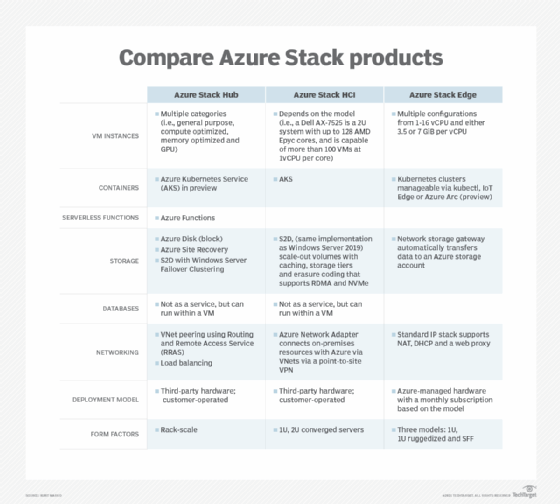
Getty Images/iStockphoto
Compare products within the Azure Stack portfolio
Azure Stack Hub, Azure Stack HCI and Azure Stack Edge all support a hybrid cloud architecture. Learn their key differences in terms of form factor, management options and more.
Each product in Microsoft's Azure Stack portfolio helps move workloads and data between enterprise locations and the public cloud. However, they target different scenarios and deployment locations.
Initially conceived as rack-scale converged infrastructure for enterprise data centers, Azure Stack technology has expanded to include hyper-converged infrastructure (HCI) and small form-factor (SFF) edge appliances. Azure Stack is now the overarching brand that comprises three products with varying capabilities and target workloads.
After IT admins evaluate their unique requirements, they need to select the Azure hybrid product that's best for their organization. Here, we break down how Azure Stack Hub, Azure Stack HCI and Azure Stack Edge compare and examine sample use cases.
Azure Stack product line and services
The Azure Stack portfolio consists of Azure Stack Hub, Azure Stack HCI and Azure Stack Edge. The portfolio targets existing Azure customers who need a hybrid cloud architecture that can span edge locations, branch offices and private data centers.
All products within the Azure Stack portfolio can exchange data with the Azure public cloud.

Azure Stack Hub. The successor to the initial Azure Stack product, Azure Stack Hub is a private, rack-scale Azure micro-region that runs a subset of Azure services. As they can with services in the Azure public cloud, admins can manage Azure Stack Hub through the Azure Resource Manager (ARM) or Azure Arc.
Azure Stack HCI. This offering is a software stack, including an OS and virtual services, for 1U or 2U server clusters of two to 16 nodes. It provides Hyper-V-based VMs, application containers managed by Kubernetes, Storage Spaces Direct (S2D) and virtualized networking. Azure Stack HCI integrates with Azure and ARM, but admins manage it primarily via the Windows Admin Center UI.
Azure Stack Edge. Previously named Data Box Edge, Azure Stack Edge is a line of 1U and small form-factor devices designed to ingest and analyze IoT and other remote data sources. These devices provide a storage gateway to simplify data transfers to the Azure public cloud. Edge Pro and Pro R (ruggedized) devices include one or two Nvidia T4 GPUs to accelerate the training and execution of machine learning (ML) models. A terabyte of NVMe storage can cache, buffer, optimize and throttle cloud data transfers and limit bandwidth usage during business hours.
For more information on how Azure Stack Hub, Azure Stack HCI and Azure Stack Edge compare, reference the table below.

Use cases
Azure Stack Hub is an extension of Azure cloud services to on-premises data centers. Enterprise users own and operate Azure Stack Hub equipment. Hub is designed for latency-sensitive workloads that must run close to users, as well as for applications that use data that can't move to the public cloud for regulatory, security or cost reasons.
Azure Stack vs. AWS Outposts vs. Google Anthos
Microsoft's vision to deliver a subset of cloud services on customer-owned hardware has been emulated by competitors. Learn how to compare Azure Stack, AWS Outposts and Google Anthos in terms of deployment, management and other components.
Azure Stack HCI is an HCI system for branch office and remote site scale-out file services, virtual desktop infrastructure, localized application environments and VM disaster recovery. Benefits for existing Azure users include add-on services such as the following:
- Azure Site Recovery
- Azure Monitor
- Azure Backup
- Azure File Sync
Azure Stack Edge Pro devices are used as IoT gateways. They locally aggregate and analyze sensor and machine data using containerized applications that run ML models on GPU-accelerated hardware. Edge Pro devices also summarize and filter collected data before it's transferred to an Azure storage repository for further analysis. The ruggedized hardware makes Edge Pro suitable for manufacturing, warehouse and outdoor locations.







